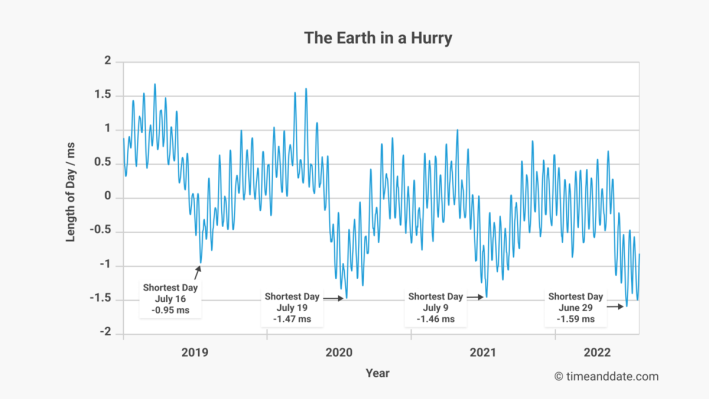Earth, a veteran planet known more for its craftiness than the quickness and explosiveness of its youth, put on a vintage performance earlier this summer, completing its fastest rotation on record. All the haters and doubters who counted Earth out are sobbing right now, absolutely sobbing.
On June 29, Earth spun through a full rotation in 1.59 milliseconds short of the league-average 24 hours, a breathtaking athletic feat witnessed by an estimated 7.97 billion viewers. This sets a record for the fastest rotation of Earth since they started tracking the stat in 1955 with the advent of the first practical atomic clock. But as we all know, athletes are only getting stronger and faster; back then Earth was competing with a bunch of plumbers and mailmen.
The world record was verified by the International Earth Rotation and Reference Systems Service, the governing body for the passage of time itself, and first reported by Timeanddate, the go-to fan blog for time news, time scores, and time trade rumors. As Timeanddate notes, June’s record-setting performance didn’t come in a vacuum. Well, it came in the vacuum of space, but you know what I mean; Earth has been enjoying a late-career resurgence. Though Earth has generally been rotating slower since its rookie year (about three milliseconds per day per century; thus the length of a day in the late Cretaceous would have been about 23 hours and 30 minutes), the last few seasons have seen Earth spinning increasingly faster.

The reasons for Earth’s comeback-player-of-the-year performance aren’t clear. Some credit a new training regimen; others a new offseason diet. Still others speculate a change in play-calling philosophy from Earth’s coach, the Sun, more suited to Earth’s abilities. Earth has also been dogged by whispers of PGH (planetary growth hormone) usage, though it’s possible those rumors were planted by its closest rivals, Mars and Venus. “It’s certainly odd,” said Professor Matt King of the University of Tasmania. “Clearly something has changed.”
Scientists, who are basically sabermetrics nerds, have a number of theories, and one of the most popular is glacial isostatic adjustment. In this scenario, climate change is melting ice caps and thereby reducing the weight on Earth’s poles, allowing the Earth, which is wider than it is tall, to decompress into a shape a little closer to a sphere. Like a figure skater drawing their arms in, this would allow the Earth to spin faster.
Another theory involves the Chandler Wobble, which is the periodic wandering of the center of rotation. Over the last couple of years—probably driven by changes in ocean circulation—the wobble has been at a historic minimum; the Earth has been more like a football thrown in a tight spiral than a Peyton Manningesque wounded duck.
“Given that changes in both of those things can be linked to mass moving around on the surface of the Earth, it’s probably not a bad guess that those things are linked in some way,” King said. “I don’t know if we are very much further along the lines of understanding what’s going on, but I dare say there’s probably something going on in the climate system or in the oceans.”
Whatever the reason or reasons, Earth’s recent performance has been so impressive that they’re considering changing the rules of the sport. A few more years of sub-24-hour times and we will need the first-ever “negative leap second”—the skipping of one second in the International Atomic Time, the official global time, in order to bring it back into alignment with the Earth’s rotation. Sure, Barry Bonds hit a bunch of dingers and set a bunch of records. But did he force us to literally jump forward in time? Earth is the greatest to ever do it.
Article From & Read More ( Earth, The True GOAT, Breaks Longstanding Speed Record - Defector )https://ift.tt/dCTDAKp
Science
No comments:
Post a Comment